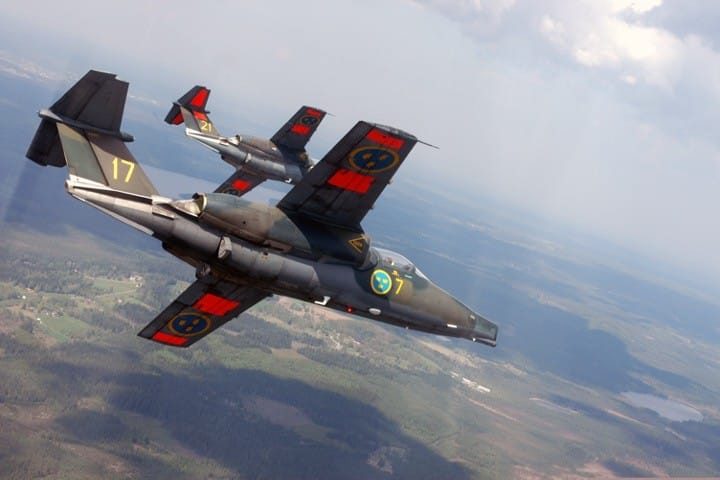
SINGAPORE — On April 24, Sweden is poised to begin its largest military drills in over thirty years.
These military exercises, labeled Aurora 23, will last three weeks and involve around 26,000 personnel from 14 countries — Sweden, the United States, the United Kingdom, Finland, Poland, Norway, Estonia, Latvia, Lithuania, Ukraine, Denmark, Austria, Germany, and France. The number of participants would exceed the entire active Swedish military force, known in Swedish as the Försvarsmakten.
Aurora 23 aims to “raise the Swedish Armed Forces’ combined ability to meet an armed attack on Sweden, and contribute to stability in the region together with others,” explained Lieutenant Colonel Henrik Larsson, who is overseeing the planning of the drills.
Participating soldiers will boost Sweden’s readiness in response to attacks and deployment, as well as large-scale land, air, and sea maneuvers. Enhancing the organization of the armed forces is another aim.
The scheduled drills will also highlight the role of logistics, testing novel methods to command and control troop and gear movements. Civil and military agencies will bolster their cooperation during the exercises, concentrating on successful joint actions should Sweden be attacked.
The Nordic country plans to stage these military exercises in the air, on the ground, and at sea, encompassing the provinces of Skane, Smaland, and the Baltic island of Gotland. Sweden returned troops to the previously demilitarized Baltic isle of Gotland after politicians and pundits pointed it out as a possible entry point for foreign invaders.
All Swedish military units are slated to participate in the upcoming drills, with battleships poised to be around both Stockholm and the Gothenburg archipelagos. With its different branches together, the Swedish military boasts around 50,000 soldiers, with reservists comprising about half that number.
Although the Swedish Armed Forces’ own exercise areas and firing ranges will be the primary venues for the drills, some of the activities will also be staged on private land.
Stockholm residents can expect to see military transport vehicles on the roads between April 29 and May 1, battleships along the coast and in the Stockholm archipelago from April 27-30, and a number of military personnel and vehicles on the streets from April 27-30. The Swedish Home Guard aims to conduct exercises in the southernmost parts of Stockholm county on April 26 and May 3, mainly on Swedish Armed Forces’ land, but also around Nynäshamn and Norrtälje.
Military representatives from the central region in Stockholm, Täby and Södertälje are slated to provide more information to the Swedish public on April 29 about the Aurora 23 exercise, the Armed Forces, and the Home Guard.
In Gothenburg, battleships and warships will be around the coastline between April 27 and May 10, with helicopters possibly in the area during the same time frame. This Swedish-language map from the Swedish Armed Forces shows how different areas will be impacted.
On April 24, Swedish public radio channel P4 will broadcast a “mobilization message” instructing participants to get into their assigned positions. This mobilization message will be the first broadcast before a military training exercise in recent times.
While Sweden has mobilized forces to international peacekeeping missions, it has not gone to war in over two centuries. Although Swedish policy long stipulated that the country required a strong military to protect its neutrality, following the demise of the Soviet Union, the Nordic country dramatically cut defense spending, shifting its military focus to peacekeeping operations.
However, recent years have witnessed Sweden ramping up its military capabilities. In April 2022, the Swedish parliament decided to increase defense spending to two percent of GDP (up from 1.3 percent in 2021), citing Russian actions in Ukraine as a reason. Neighboring Finland added over €2 billion to its €5.1 billion defense budget over the next four years. According to data from the Global Fire Power (GFP) Index, Sweden in 2023 ranks 37th out of the 145 countries reviewed for military strength.
Together with Finland, Sweden also ended its landmark policy of military nonalignment by applying to join NATO last year. Although the two neighbors originally planned to join the bloc together, Helsinki reached that goal first, as Stockholm’s bid met with opposition from NATO members Hungary and Turkey.
Ankara has repeatedly clashed with Stockholm, claiming that Sweden has not met its demands, especially for the extradition of Turkish citizens whom Turkey hopes to prosecute for “terrorism.” The country also lambasted Sweden for offering a safe haven for “terrorists,” particularly members of the Kurdistan Workers’ Party, or PKK.
Hence, Sweden’s hopes of joining NATO could hinge on the outcome of Turkey’s presidential election in May, in which recent polls show President Recep Tayyip Erdoğan’s two-decade rule possibly ending.
“The signals that Sweden has gotten from the opposition have been very good,” Paul Levin, director of Stockholm University’s Institute for Turkish Studies, said of the National Alliance coalition of six parties challenging Erdoğan. “The opposition has indicated that they would ratify Sweden’s NATO membership rather soon.”
In recent months, Erdoğan’s popularity in Turkey has fallen considerably owing to the country’s economic hyperinflation and February’s large-scale destructive earthquakes, which took over 50,000 lives and which some claim were triggered by the United States to punish Erdoğan for not abiding by Western demands.
As Erdoğan’s problems have escalated, Kemal Kılıçdaroğlu, the leader of Turkey’s National Alliance coalition, has started to surpass Erdoğan in popularity, at least based on recent polls reported by the mainstream media.
“If Kemal Kılıçdaroğlu wins the presidential elections, the chances for Sweden to become a member of NATO would increase,” foreign policy analyst Pinar Sayan, an associate fellow at the Istanbul Political Research Institute, told Yahoo News.
“It was good domestically for Erdoğan to green-light Finland and red-light Sweden,” former U.S. diplomat Elizabeth Shackelford, now a senior fellow at the Chicago Council on Global Affairs, revealed in an interview with the news site. “It’s a pretty clear demonstration of the power he wields inside NATO. Erdoğan’s making Türkiye’s position hugely relevant for the world’s most important defense alliance.” She elaborated that Erdoğan is “keeping a card he can still play to get further concessions from NATO members,” including an F-16 deal with Washington.
Soner Çağaptay, director of the Turkish Research Program at the Washington Institute for Near East Policy, admitted the significance of Sweden passing a new counterterrorism law. “If Erdoğan wins, he’ll make the case that Sweden went to its knees and agreed to Türkiye’s demands,” Çağaptay said.



